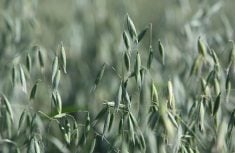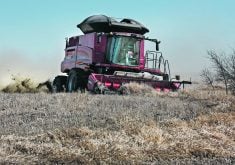The primary goal in forage pro-
duction is to preserve quality until it can be fed.
Harvest losses can derail a hay producer’s plan for top quality forage. Losses can range from 10 percent for grass hay to 35 percent for legumes. These losses can be avoided by understanding how they occur.
Do not rotate the bale more times than necessary to secure it when wrapping twine. The fines, primarily leaves that fall from the bale chamber during twine wrapping, are an indication of bale chamber loss. These fines contain the highest level of nutrients, so it is important to minimize their loss.
Read Also

VIDEO: Green Lightning and Nytro Ag win sustainability innovation award
Nytro Ag Corp and Green Lightning recieved an innovation award at Ag in Motion 2025 for the Green Lightning Nitrogen Machine, which converts atmospheric nitrogen into a plant-usable form.
Conditioning
Freshly cut hay is typically 80 percent moisture, and must lose about 6,000 pounds per acre of water for each ton of hay at 20 percent moisture.
Conditioning speeds drying by opening the waxy cuticle layer surrounding the stem. This allows moisture to evaporate faster and reduces time in the windrow.
The conditioner must be adjusted correctly to maintain adequate and uniform roll pressure along the entire length.
Apply sufficient roll pressure to the hay to cause a noticeable breaking of the stem skin, but not so much pressure that leaves fall off. Proper adjustment of rollers can keep dry matter losses at one to three percent.
Tedding
Tedding fluffs, spreads or moves the windrow of hay, but should be done when the hay is still at least 40 percent moisture to reduce leaf loss, especially on legume hay.
Some tedders simply shift the windrow several feet onto a drier area while others spread out, invert or fluff the windrow.
All these operations may improve drying, but high leaf loss can occur when the tedder is too aggressive or the hay is too dry. This operation is better suited to grass hay fields, where dry matter losses are minimal.
Raking
Raking is typically done to pull two or more windrows into one. However, raking can cause more leaf loss in hay than any other harvest operation. Avoid raking legumes when moisture levels are below 35 percent.
If the rake is power take-off driven, synchronize field speed and pto speed to provide a gentle lifting and turning action. This avoids aggressive forage handling and excessive leaf loss.
To form bales of consistent density and shape, make windrows uniform in width and in the amount of hay contained.
Moisture content
Hay moisture content is the largest single factor contributing to leaf loss. Hay baled above 15 percent has much less leaf loss.
When hay becomes too dry and brittle, stop baling and resume in the evening or morning when the leaf moisture level increases.
Dew-moistened hay can be baled at a slightly higher moisture level than when drying down because dew moisture in the hay is more easily released during curing than internal moisture. The upper moisture level depends on the type of hay, density and size of bale, drying conditions after baling and other factors. The upper moisture limit for large round alfalfa bales is typically 18 to 20 percent. Hay baled much above 20 percent moisture will usually spoil unless chemical preservatives such as propionic acid are added to the hay.
Effective hay preservatives will prevent excessive heating and mould growth when applied uniformly and at the correct rate. Wet bales are not only at risk for spoilage, but also fires.
The baler
A baler pickup typically causes a one to three percent loss, but it can be as high as 12 percent depending on field speed, size of windrow, hay moisture content and mechanical condition of the pickup mechanism, including broken and bent pickup teeth.
High moisture content reduces pickup loss, so avoid baling when the hay is overly dry, especially with legume forages.
Synchronize ground speed to pickup speed to reduce this loss.
The bale chamber is another area of potential loss, normally two or three times higher in a large round baler than a rectangular baler.
To minimize this, moisture content should be as high as possible that will allow for safe storage. The feed rate should be as high as possible to minimize the number of turns each bale makes within the chamber.
Field loss occurs as the bale turns within the bale chamber, so don’t create unnecessary loss by running the baler when there is no hay feeding into the chamber.
Large windrows and high forward speeds will increase the feed rate. If the windrows are small or field speeds must be slow, then reducing the pto speed will result in fewer revolutions to form a bale.
















